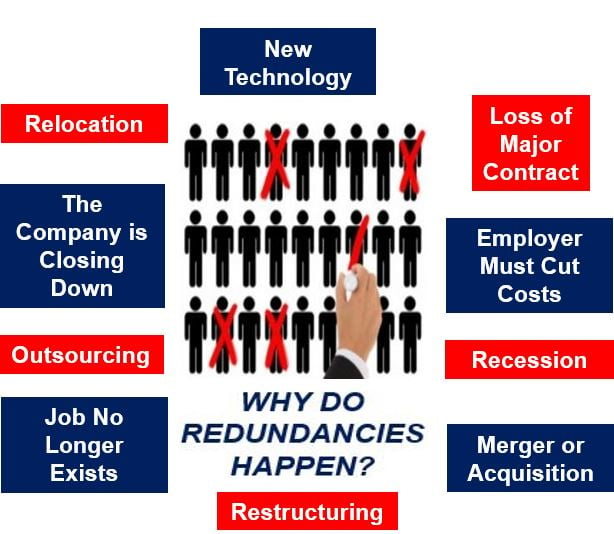Who Pays Redundancy Money? A Comprehensive Overview for Companies and Employees
Who Pays Redundancy Money? A Comprehensive Overview for Companies and Employees
Blog Article
Exploring the Interaction Between Firm Redundancy and Organizational Flexibility for Future Growth
In the dynamic landscape of today's business globe, the elaborate connection between firm redundancy and organizational adaptability emerges as an essential aspect for sustained growth and success. Companies commonly encounter the challenge of striking a fragile equilibrium in between preserving a level of redundancy to minimize dangers and fostering adaptability to respond promptly to the ever-evolving market demands.
Importance of Business Redundancy
Business redundancy is a critical aspect that enhances business strength and reduces operational risks. By including redundancy steps within the organizational structure, business can much better stand up to unexpected disturbances and fluctuations in business setting. Redundancy functions as a tactical buffer, permitting companies to adjust and react efficiently to unforeseen difficulties without jeopardizing crucial operations.
One secret facet of the significance of business redundancy is its role in making sure continuity throughout times of situation. When confronted with unexpected modifications or emergencies, redundant systems, sources, or workers can action in to preserve crucial functions and avoid prevalent interruptions. This continuity not only safeguards the company's online reputation and client trust fund however additionally reduces financial losses and functional downtime.

Techniques for Business Versatility

One more essential technique is buying modern technology and facilities that can support versatility and scalability. Executing electronic tools, automation, and data analytics can simplify procedures, boost effectiveness, and supply useful understandings for educated decision-making. Furthermore, developing adaptable organizational structures that enable quick adjustments to market dynamics and customer requirements is necessary for remaining competitive in a rapidly advancing environment. By proactively determining possible disruptions and chances, organizations can proactively adapt and flourish in an ever-changing company landscape.
Harmonizing Redundancy and Adaptability
Attaining a harmonious equilibrium between operational redundancy and business versatility is vital in browsing the intricacies of a vibrant company setting. Redundancy within a company offers a safeguard, ensuring connection and stability in procedures. Nevertheless, an unwanted of redundancy can result in inefficiencies and impede versatility to changing market conditions. On the various other hand, organizational versatility permits companies to react without delay to external disruptions and confiscate brand-new opportunities. Striking the right balance between redundancy and flexibility is a fragile process that calls for a deep understanding of the company's goals, sector dynamics, and threat resistance.
To attain this balance, business require to conduct routine assessments of their operations to determine locations where redundancy is needed for risk reduction and where flexibility can drive technology and development. Applying adaptable frameworks, fostering a culture of constant knowing and enhancement, and encouraging open interaction throughout all levels of the organization are essential approaches to harmonize redundancy and flexibility efficiently. By aligning these 2 vital components, firms can position themselves for sustainable growth and success in an ever-changing service landscape.
Instance Research Studies on Adaptation Success
In analyzing circumstances of effective organizational adaptation, it becomes noticeable that the interplay between functional redundancy and flexibility is a specifying element in forming resistant companies. One compelling study is that of Netflix. Initially a DVD rental service, Netflix demonstrated remarkable adaptability by transitioning right into a streaming system when digitalization interrupted the industry. By strategically investing in technology and web content development, Netflix not only endured however flourished in a swiftly progressing market. Another standout instance is Amazon. Beginning as an on the internet book shop, Amazon continually adapted its company version, increasing right into varied markets such as cloud computing and fabricated knowledge. This versatility allowed Amazon to remain in advance of rivals and fulfill altering consumer needs. Finally, Adobe offers a significant picture of effective adjustment. The business changed from selling software application licenses to a subscription-based version, guaranteeing persisting earnings streams and boosted client interaction. These study emphasize the relevance of functional redundancy coupled with organizational adaptability in fostering long-lasting development and competitiveness.
Building Durability for Future Growth
Structure durability for future development needs a web strategic placement of functional processes with market characteristics and arising fads. Business should adjust to changing settings by fostering a culture of flexibility, advancement, and continuous improvement.
Additionally, fostering strong partnerships with stakeholders, such as customers, workers, suppliers, and the community, is necessary for weathering uncertainties and keeping trust and support during turbulent times. Efficient interaction and transparency play a vital role in building durability, as they assist align assumptions and facilitate partnership in navigating uncertainties.
Additionally, companies need to focus click this site on learning and development initiatives to upskill staff members and equip them with the essential tools to adjust to altering circumstances. By purchasing their labor force, companies can improve their adaptability and agility, inevitably enhancing their durability for lasting future development.
Final Thought

In the vibrant landscape of today's business world, the complex connection in between business redundancy and business versatility arises as an important factor for sustained growth and success. Firms often deal with the difficulty of striking a fragile equilibrium between preserving a level of redundancy to mitigate threats and promoting flexibility to react promptly to the ever-evolving market needs.To accomplish this equilibrium, companies require to carry out routine evaluations of their operations to identify areas where redundancy is required for risk reduction and where versatility can drive development and growth.In conclusion, the interaction between company redundancy and business versatility is crucial for future growth. Building durability with a additional resources mix of redundancy and versatility will ensure that companies are prepared for the obstacles of the future.
Report this page